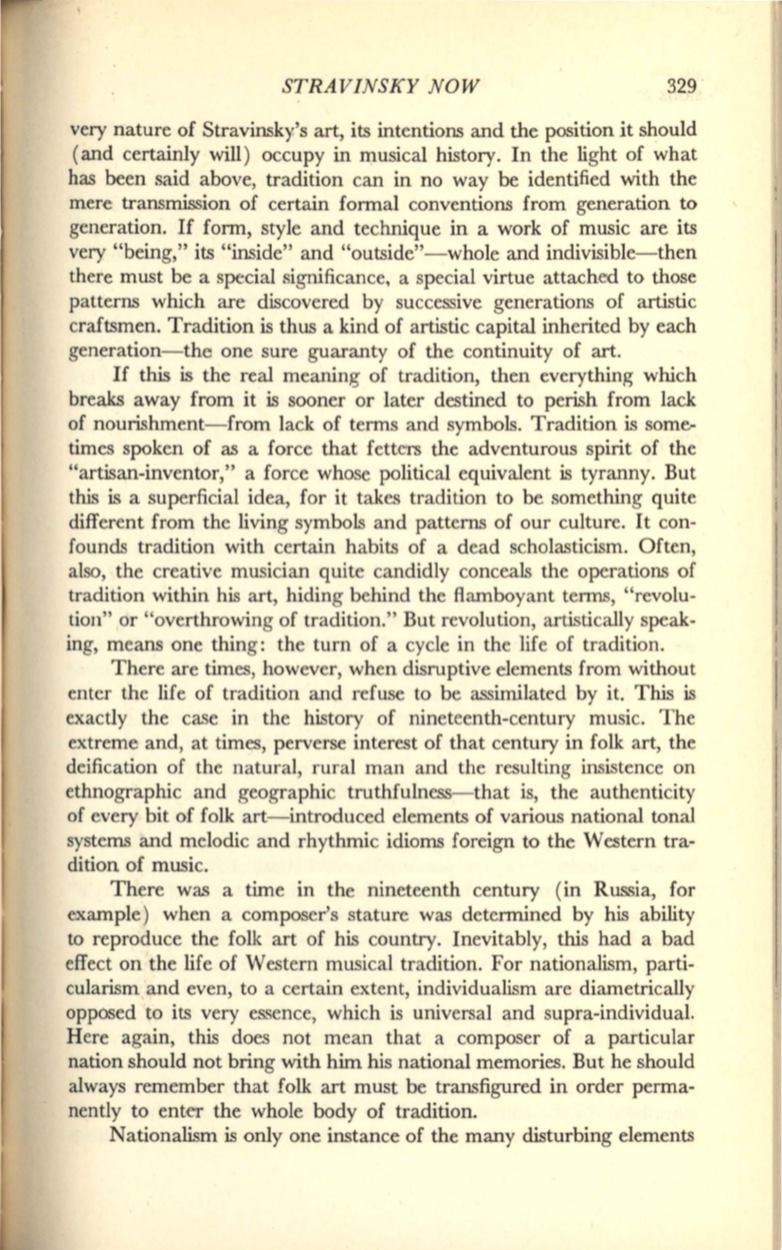
STRAVINSKY NOW
329
very nature of Stravinsky's art, its intentions and the position it should
(and certainly will) occupy in musical history. In the light of what
has been said above, tradition can in no way be identified with the
mere transmission of certain formal conventions from generation to
generation.
If
form, style and technique in a work of music are its
very "being," its "inside" and "outside"-whole and indivisible-then
there must be a special significance, a special virtue attached to those
patterns which are discovered by successive generations of artistic
craftsmen. Tradition is thus a kind of artistic capital inherited by each
generation-the one sure guaranty of the continuity of
art.
If
this is the real meaning of tradition, then everything which
breaks away from it is sooner or later destined to perish from lack
of nourishment-from lack of terms and symbols. Tradition is some–
times spoken of as a force that fetters the adventurous spirit of the
"artisan-inventor," a force whose political equivalent is tyranny. But
this is a superficial idea, for it takes tradition to be something quite
different from the living symbols and patterns of our culture. It con–
founds tradition with certain habits of a dead scholasticism. Often,
also, the creative musician quite candidly conceals the operations of
tradition within his
art,
hiding behind the flamboyant terms, "revolu–
tion" or "overthrowing of tradition." But revolution, artistically speak–
ing, means one thing: the turn of a cycle in the life of tradition.
There are times, however, when disruptive elements from without
enter the life of tradition and refuse to be assimilated by it. This is
exactly the case in the history of nineteenth-century music. The
extreme and, at times, perverse interest of that century in folk art, the
deification of the natural, rural man and the resulting insistence on
ethnographic and geographic truthfulness-that is, the authenticity
of every bit of folk art-introduced elements of various national tonal
systems and melodic and rhythmic idioms foreign to the Western tra–
dition of music.
There was a time in the nineteenth century (in Russia, for
example) when a composer's stature was determined by his ability
to reproduce the folk art of his country. Inevitably, this had a bad
effect on the life of Western musical tradition. For nationalism, parti–
cularism and even, to a certain extent, individualism are diametrically
opposed to its very essence, which is universal and supra-individual.
Here again, this does not mean that a composer of a particular
nation should not bring with him his national memories. But he should
always remember that folk
art
must be transfigured in order perma–
nently to enter the whole body of tradition.
Nationalism is only one instance of the many disturbing elements


